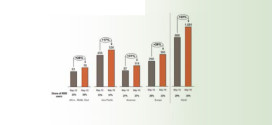Global foreign direct investment (FDI) inf lows were only slightly higher in 2010 than in recessionhit 2009, according to estimates from the Economist Intelligence Unit (EIU).
Growth in FDI inflows to emerging markets – by an estimated 14 per cent – offset another decline in flows to the developed world of an estimated seven per cent. Global FDI inflows are projected to increase by about 16 per cent in 2011, to US$1.3 trillion, which will still be far below the peak of US$2.1 trillion recorded in 2007.
The global economic crisis in 2008-09 had a major impact on FDI flows. After declining in 2008 by 16.5 per cent to US$1.77 trillion, global FDI inflows plunged by 40 per cent to US$1.06 trillion in 2009. The fall reflected the credit crunch, the deep recession in the developed world and many emerging markets and a large-scale retreat from risk.
It was generally expected that recovery from recession would be accompanied by a relatively robust rebound in global FDI flows in 2010. In the event, they are estimated to have been only slightly higher than in 2009, by some four per cent in US dollar terms.
According to Laza Kekic, the EIU’s director for country forecasting services, “a continued lack of confidence and the European sovereign debt crisis have clearly had a dampening effect on FDI f lows to much of the developed world”.
The sharp decline in global FDI f lows in 2009 was accompanied by a distinct shift in the pattern of FDI; for the first time ever emerging markets attracted more FDI than developed countries. That trend continued and indeed strengthened in 2010. FDI f lows to emerging markets have held up as the gap in economic performance with the developed world has widened. The trend of improving business environments in many emerging markets in recent years has strengthened the “pull factor” for FDI.
Among emerging markets, Asia remained the largest recipient of FDI ($260bn) and China the single-largest recipient (US$100bn), ranking second globally.
 Cash And Trade Magazine For Cash and Trade professionals in the Middle East
Cash And Trade Magazine For Cash and Trade professionals in the Middle East




